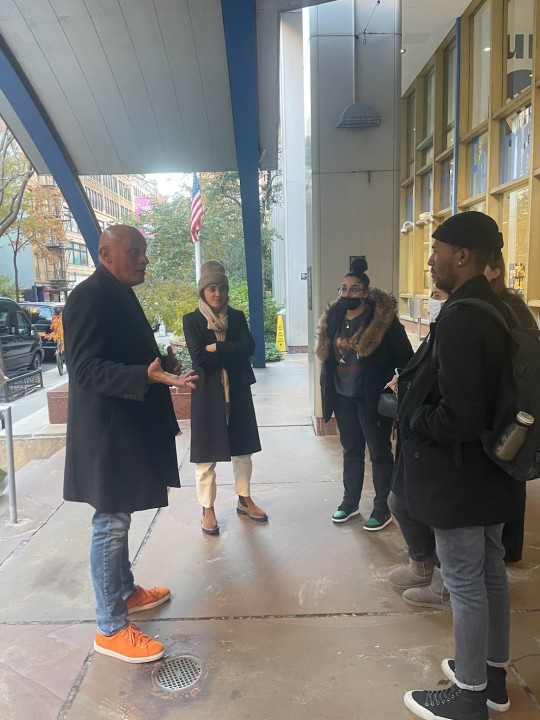Do you know one of those moments of intellectual urgency where ideas flow from one to another and create new ones, and you’re having so much fun that you zone out from reality?
I recall one such moment when World Traveler, Business Owner, Entrepreneur, and my good friend Scott Eddy, visited my class to engage with my students and share his story.
I remember the scene vividly: he was seated on a desk with his back to the blackboard while the rest of the class, including myself, attentively sat facing him. We were so invested in the discussion!
Scott shared his life story and tips on building a brand while embodying the practice to my My 4 I’s methodology . We were charged with ideas, and the discussion moved naturally from one discovery to another, and everybody had unique values to share.
Authenticity over inauthenticity: get rooted in your identity and intention
The pandemic was great for the corporate world because it weeded out companies that lacked the substance needed to sustain them through turbulent times. Survival of the fittest, as they say. The ones with a weak foundation and inauthentic value system couldn’t optimize themselves according to the changing times. But, on the other hand, the ones with solid roots in their identity survived the pandemic; in fact, some came out stronger than before!
This happened because of a well-synced identity and intention within the organization that drove innovation. Its people relied on the company’s intention and implementation strategy to turn a disadvantage in their favor. The leaders innovated a way to retune and deliver the company’s simple marketing promise to match the needs of the changing times!
For this very reason, brands need a robust core values system and dynamic processes to translate their vision into different forms. You always need to be prepared to pivot overnight so your audience can see themselves in you.
The need for a digital infrastructure in your implementation strategy.
People forget a crucial detail of marketing while building their brand and expanding their online reach, and that forms a significant part of the implementation strategy. And Scott has invaluable advice for us!
In order of importance, your social media reach is more important than your social media content. You approach first; you attract next. Social media is the world wrapped up in a phone, and you can meet anybody there. It’s a prepared platform for those who want to reach out to others; all one needs to do is put content out there. You might be meeting people, handing out cards, and forming new relationships in real life, but you can do it faster on social media. Scott’s go-to social media platform is Twitter, which is worth 80% of his brand. But he reaches his ideal audience on multiple social media platforms through ad campaigns and by posting relatable content.
The key to making your presence known by posting regularly. As a brand, you need to put yourself out there and engage with people through what best represents you and piques their interest.
So even if your identity and intention are well in place, if you cannot communicate them through any medium (here, online and offline networking), then you fail to make an impact.
You build your audience through constant effort.
Turn that warm lead into something meaningful.
Knowing your audience and building a support system out of meaningful relationships is an integral part of your journey towards success. My 4 I’s methodology is people-oriented, and Scott’s ideas stand as an excellent example of how one can make the best out of leads—good or bad.
According to Scott, your satisfied customers and partners are torchbearers for your cause, and they represent all that you stand for. They make up the support system that guides you on your quest for improvement and growth. Therefore, you must keep them at all costs.
But of course, there will also be people who don’t like what you’re doing. So you can consider such people as your critics who help you reflect and improve without making you lose confidence. Because there will always be people who are immersed in what you do and function as the core source of your strength.
Whether that lead is in your favor or against you, turn it into something meaningful for yourself and others.
People don’t want perfection; they want representation.
Insincerity is a major enemy of creativity and trust in the corporate sphere: gimmicks that make the audience feel small compromise the purpose and impact of an initiative. Regardless of its purpose, a brand must bring meaningful improvement in the audience’s lives instead of preying on them for profit.
As per Scott, cosmetic brands of today are trying to sell themselves on a very inauthentic idea of diversity in the beauty industry. Despite recognizing individual beauty, they are forcing beauty standards upon us through the media and social media. Scott believes that everyone is different, so beauty is subjective. There are different types of beautiful, and yours is one of them.
You craft your own beautiful, don’t give that power away to industries.
To compete with such insincere standards, a brand needs a story that connects with the audience. A simple yet powerful example from the pandemic is small business owners shooting videos with phone cameras for their social media feed. These videos are shaky, unedited, and very natural. Why did that connect with the audience? Because the world is shaken and not everything is available easily. It represents the predicament of an unprecedented situation. The video-shooting method is a story in itself that draws people in.
Scott says that you are not selling your product to the perfect individual; you’re selling it to people with flaws and insecurities. These people represent your brand better because they symbolize the spontaneity of being a unique human.
And that is the true source of your motivation for making an impact!
Embracing the novelty of your ideas
As the discussion continued, Scott came up with a brilliant idea of making a video out of students’ vision behind creating their brands. It was a delightful experience, watching students open up about their beliefs and personal experiences and connect them to a larger cause beyond them.
What sells a brand is not its product but a compelling story.
The students incorporated Emily Estaphani Smith’s four attributes of meaning: purpose, belonging, transcendence, and storytelling. It was exciting to see students taking ownership of what defines them, turning meanings around, playing with ideas, challenging the norm, and building something entirely personal but still managing to represent a group of people sharing similar interests.
There was an unexpected twist with every idea as we watched the birth of a business idea in its rawest and most authentic form!

